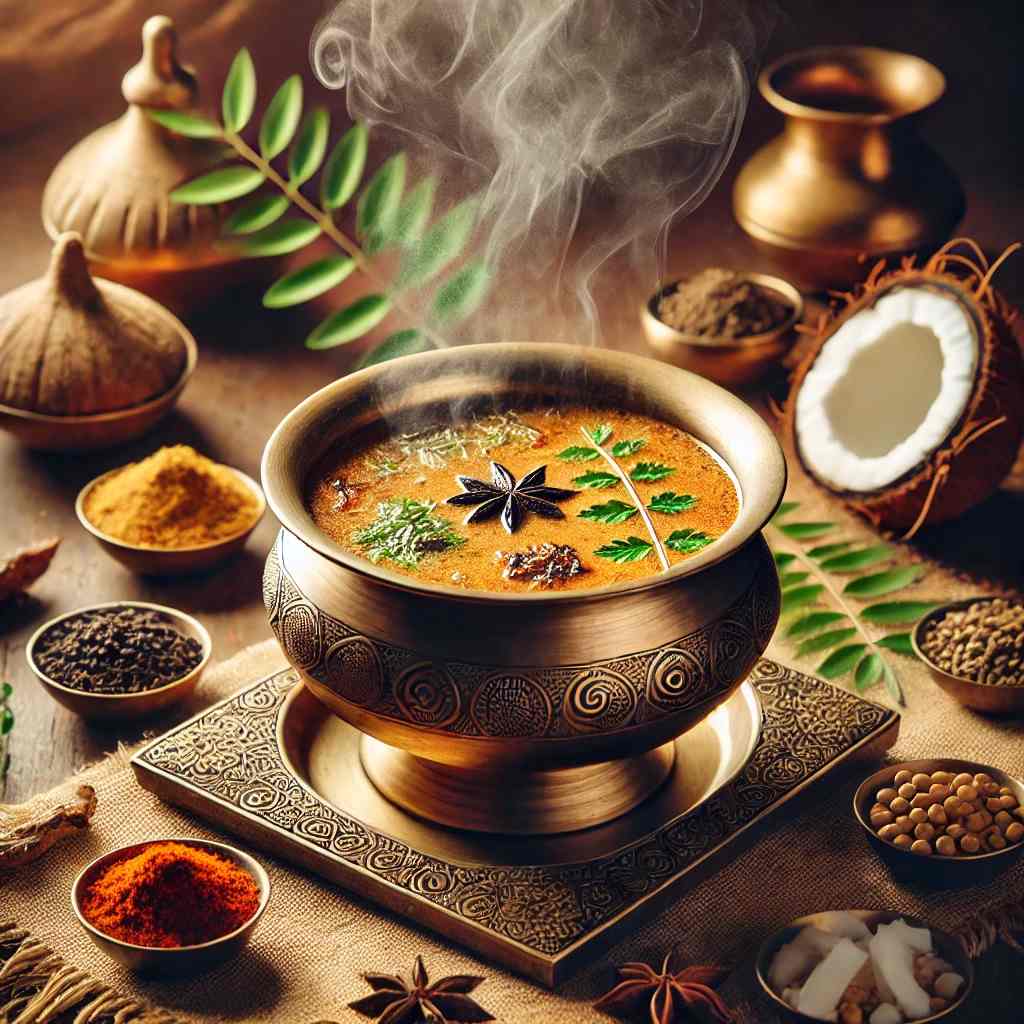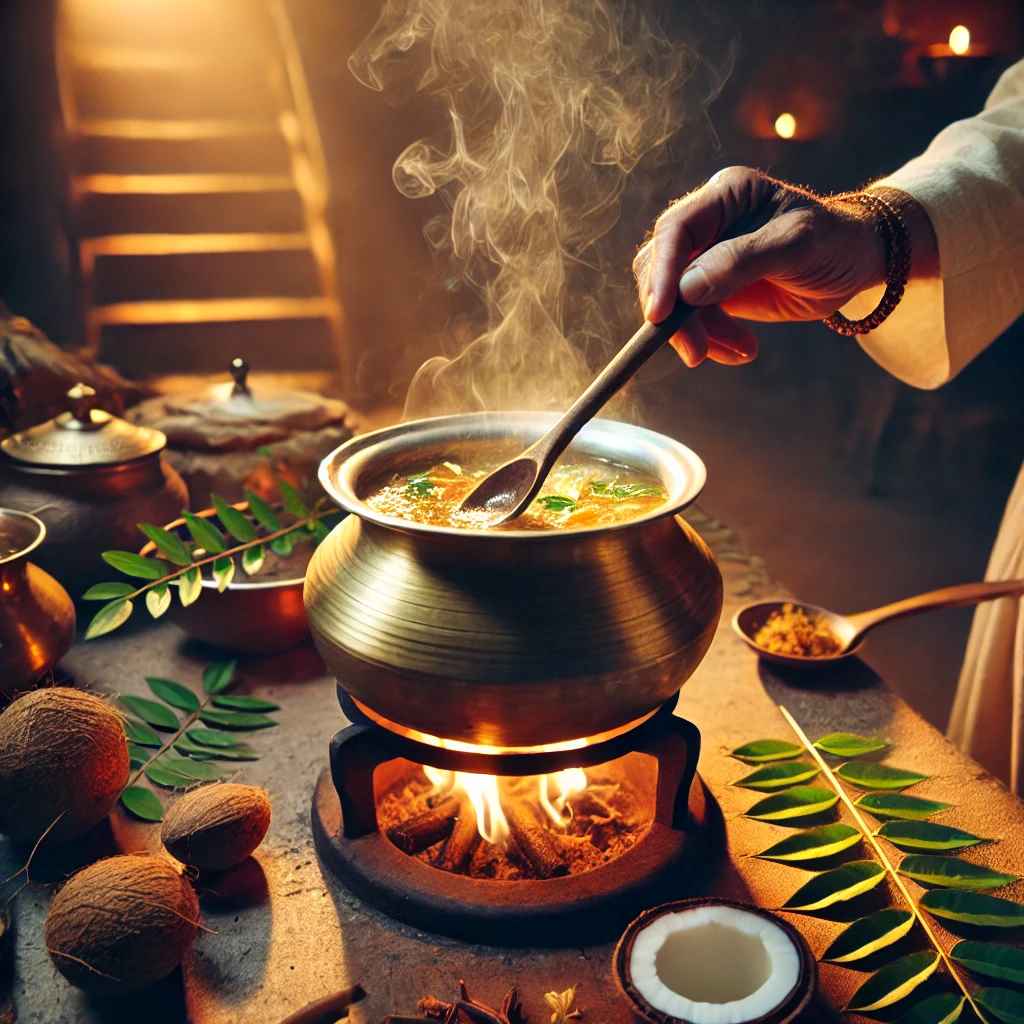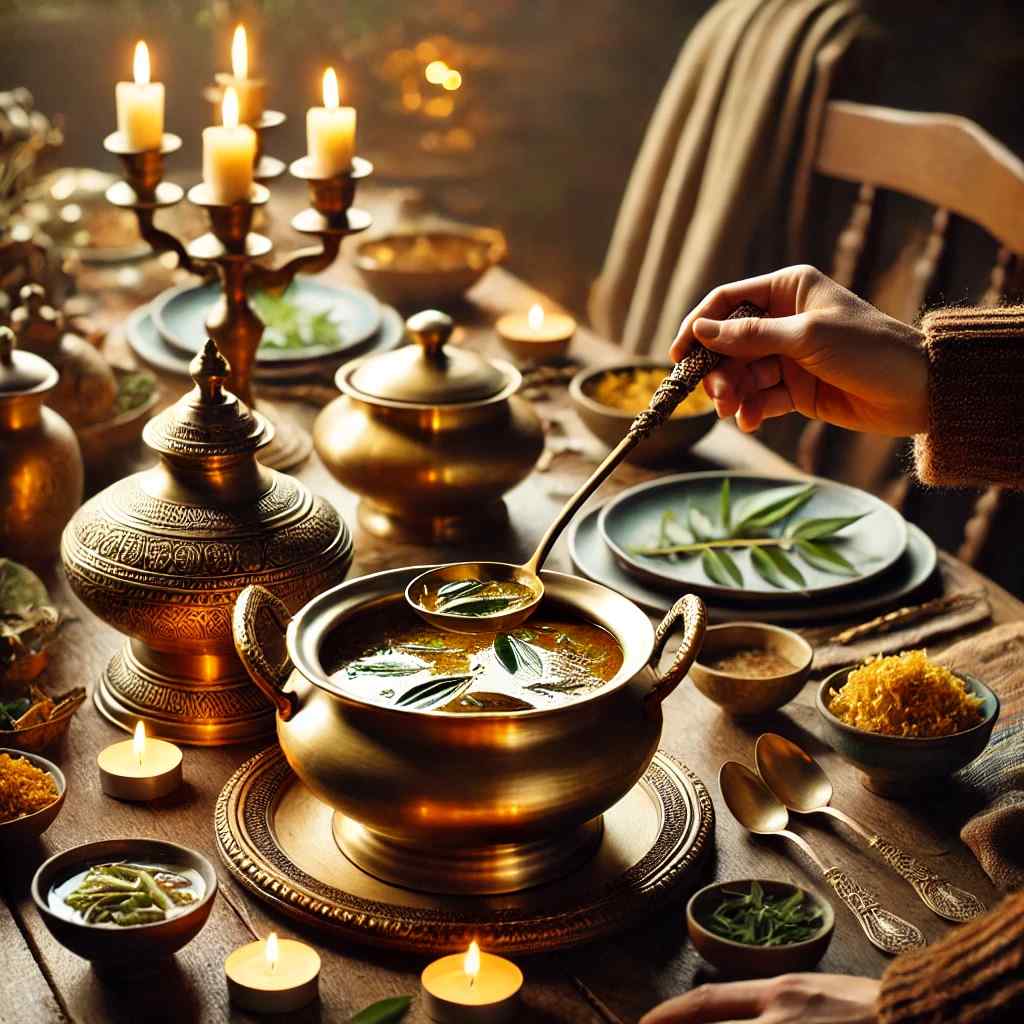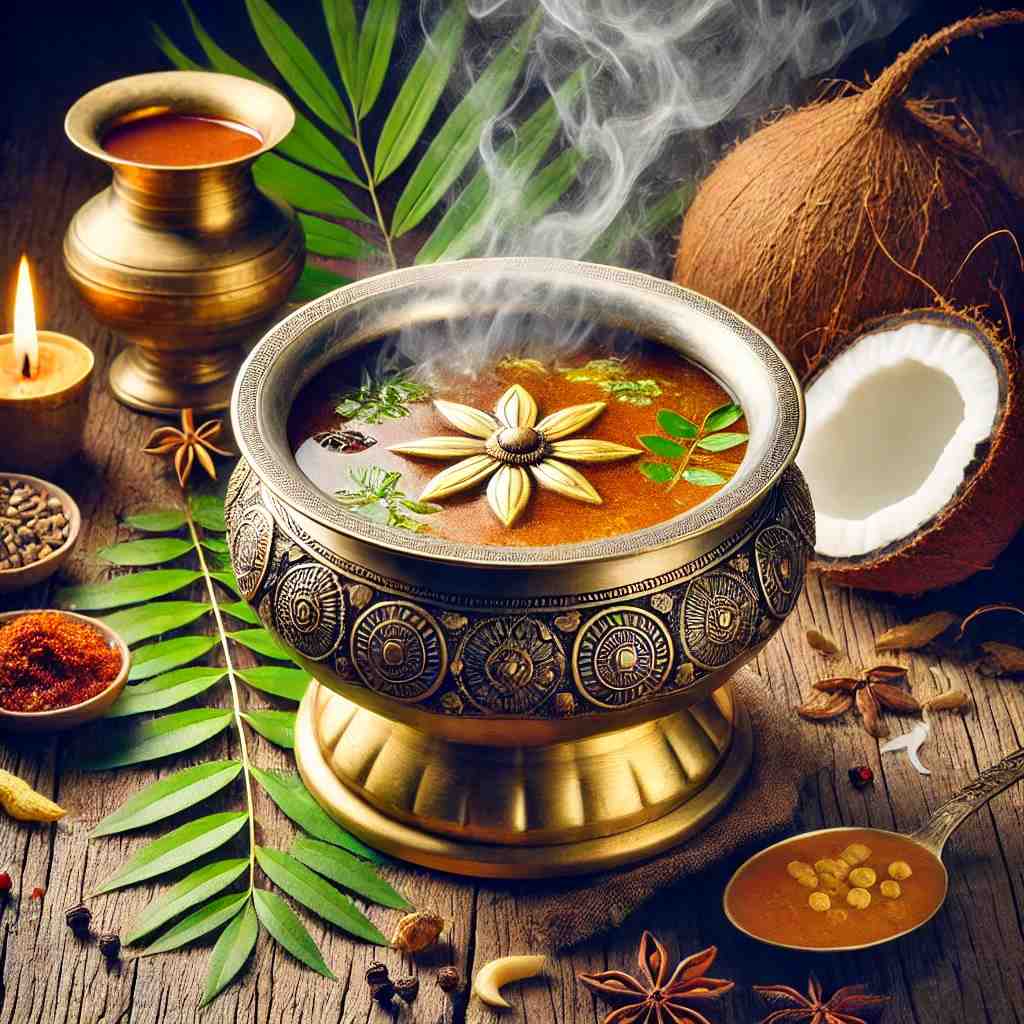Introduction
Have you ever craved a dish that transports you straight to the sun-kissed shores of coastal India, where the aroma of spices mingles with the salty sea breeze? Well, get ready to embark on a flavorful journey! Devasthana Saaru, an authentic Konkani recipe, is your ticket to a culinary adventure that’s both soul-soothing and taste bud-tingling.
Imagine this: you’re in a cozy kitchen, the distant sound of waves crashing against the shore, as you stir a bubbling pot filled with rich, aromatic broth. The scent of tamarind and freshly ground spices fills the air, wrapping you in a warm hug of nostalgia. Devasthana Saaru isn’t just a dish; it’s an experience—a delightful blend of tradition, culture, and pure deliciousness.
Ready to dive in? Grab your apron, and let’s bring this easy Konkani recipe to life in your very own kitchen!
Table of Contents

What is Devasthana Saaru?
So, what exactly is this enchanting concoction called Devasthana Saaru? Let’s unravel the mystery behind this delightful dish that’s been a well-kept secret among Konkani households for generations.
Cultural Significance
Devasthana Saaru, literally translating to “temple broth,” holds a sacred place in Konkani culture. Traditionally prepared during temple festivals and religious ceremonies, this dish is more than just food—it’s a symbol of devotion and community. By cooking Devasthana Saaru, you’re not just preparing a meal; you’re partaking in a ritual that has brought families together for centuries.
In the coastal regions of Karnataka and Goa, temples serve as community hubs where people gather not only to worship but also to celebrate through food. Devasthana Saaru is often served as prasadam (blessed food), shared among devotees as a token of divine grace. When you make this dish, you’re recreating a piece of that sacred tradition right in your own home.
Unique Flavor Profile
What sets Devasthana Saaru apart from other broths or soups is its harmonious blend of flavors. It’s a delightful medley of tangy tamarind, sweet jaggery, creamy coconut, and a bouquet of aromatic spices. The result? A broth that’s both comforting and invigorating, with layers of taste that unfold with each sip.
Picture this: the first spoonful greets you with a gentle tanginess, soon followed by the warmth of roasted spices, and finally, a subtle sweetness that lingers on your palate. It’s a symphony of flavors that dance together, making every mouthful an absolute delight.
Traditional Roots
The beauty of Devasthana Saaru lies in its simplicity and the authenticity of its preparation. Passed down through generations, the recipe has remained largely unchanged, preserving the essence of Konkani culinary heritage. By choosing to cook this dish, you’re not just making a meal; you’re embracing a tradition that has stood the test of time.
In an era where fast food and quick fixes dominate, taking the time to prepare Devasthana Saaru is a nod to the art of slow cooking and the joy of savoring each step in the culinary process. It’s about connecting with your roots, honoring the past, and creating something truly special.
The History and Origins of Devasthana Saaru
To truly appreciate Devasthana Saaru, let’s take a stroll down memory lane and explore its rich history.
Roots in Temple Traditions
As the name suggests, Devasthana Saaru has its origins in temples, where it was prepared as an offering to the deities. Temples in the Konkan region were not just places of worship but also community centers where food played a central role in bringing people together.
The saaru prepared in temples was considered pure and sacred, made with the freshest ingredients and utmost devotion. This reverence for the dish elevated it from a simple broth to a spiritual experience.
Influence of Regional Ingredients
The coastal belt of India is blessed with an abundance of coconuts, spices, and legumes—all of which feature prominently in Devasthana Saaru. The use of local ingredients not only enhances the flavor but also reflects the region’s agricultural bounty.
Over time, as trade routes expanded, new spices and cooking techniques were introduced, enriching the recipe further. Yet, the core essence remained untouched, preserving its authentic taste and significance.
Culinary Evolution
While the traditional recipe has been carefully guarded, each generation has added its own touch, subtly tweaking the flavors to suit contemporary palates. This evolution ensures that Devasthana Saaru remains a living tradition, resonating with both the young and old.
Symbolism and Community
In many ways, Devasthana Saaru symbolizes unity and togetherness. Preparing and sharing this dish is an act of love and hospitality, reflecting the Konkani ethos of community living. It’s not just about feeding the body but also nourishing the soul.

Ingredients for Easy Devasthana Saaru Recipe
Ready to gather your ingredients? Let’s get everything you need to create this mouthwatering dish. Don’t worry; this easy Konkani recipe calls for simple ingredients that you might already have in your pantry!
Main Ingredients
Here’s a handy table to help you organize your shopping or pantry check.
| Ingredient | Quantity | Notes |
|---|---|---|
| Toor Dal (Split Pigeon Peas) | 1 cup | Also known as arhar dal |
| Tamarind Pulp | Lemon-sized ball | Soak tamarind in warm water and extract pulp |
| Grated Coconut | 1/2 cup | Fresh or frozen |
| Dry Red Chilies | 4-5 | Adjust to your spice preference |
| Coriander Seeds | 2 teaspoons | Adds citrusy undertones |
| Cumin Seeds | 1 teaspoon | Earthy flavor enhancer |
| Mustard Seeds | 1 teaspoon | For tempering |
| Curry Leaves | A sprig | Fresh leaves for best flavor |
| Asafoetida (Hing) | A pinch | Aids digestion |
| Turmeric Powder | 1/2 teaspoon | Natural color and anti-inflammatory |
| Jaggery | 1 tablespoon | Balances the tanginess |
| Salt | To taste | Essential for flavor |
| Oil or Ghee | 2 tablespoons | Ghee adds richness; oil keeps it vegan |
Optional Ingredients
- Garlic Cloves: 2-3, minced. Adds a robust flavor.
- Black Peppercorns: 1/2 teaspoon, crushed. For an extra kick.
Ingredient Spotlight
- Toor Dal: A staple in Indian kitchens, it’s packed with protein and gives the saaru a creamy texture.
- Tamarind Pulp: The soul of the dish, providing that signature tanginess.
- Jaggery: A natural sweetener that balances the sourness of tamarind.
Pantry Check!
Before you start cooking, make sure you’ve got all your ingredients lined up. Trust me, having everything within arm’s reach makes the cooking process a breeze!

Step-by-Step Preparation of Devasthana Saaru
Time to get cooking! Follow these steps, and you’ll have a pot of delicious Devasthana Saaru ready to impress.
Step 1 – Preparing the Dal
1. Wash and Soak
- Rinse 1 cup of toor dal under running water until the water runs clear.
- Soak the dal in water for about 15 minutes. This helps it cook faster.
2. Cook the Dal
- Transfer the soaked dal to a pressure cooker.
- Add 2 cups of water and a pinch of turmeric powder.
- Cook for 3-4 whistles or until the dal is soft and mushy.
- If using a pot, cook until the dal is tender, which may take about 30-40 minutes.
Tip: Adding a few drops of oil to the dal while cooking prevents frothing.
Step 2 – Making the Spice Paste
1. Roast the Spices
- In a pan, dry roast:
- 4-5 dry red chilies
- 2 teaspoons coriander seeds
- 1 teaspoon cumin seeds
- Roast on medium heat until aromatic, stirring continuously to avoid burning.
2. Grind to a Paste
- Allow the roasted spices to cool slightly.
- In a blender, combine:
- Roasted spices
- 1/2 cup grated coconut
- Tamarind pulp
- Add a little water and blend to a smooth paste.
Optional: If adding garlic and peppercorns, include them in the blending process for enhanced flavor.
Step 3 – Combining Ingredients
1. Mix Dal and Spice Paste
- In a large pot, combine the cooked dal and the spice paste.
- Stir well to ensure they are fully incorporated.
2. Add Seasonings
- Add:
- 1 tablespoon jaggery
- Salt to taste
- Mix thoroughly.
3. Simmer
- Add water to achieve your desired consistency (usually 2-3 cups).
- Bring the mixture to a boil, then reduce heat and let it simmer for about 10 minutes.
Tip: Skim off any foam that rises to the top for a clearer broth.
Step 4 – Tempering (Tadka)
1. Heat Oil/Ghee
- In a small pan, heat 2 tablespoons of oil or ghee over medium heat.
2. Add Tempering Ingredients
- Add 1 teaspoon mustard seeds. Allow them to splutter.
- Add a sprig of curry leaves and a pinch of asafoetida.
- Sauté for a few seconds until fragrant.
3. Combine
- Carefully pour the tempering over the simmering saaru.
- Stir gently to mix.
Final Touches
- Let the saaru simmer for another 2 minutes to allow the flavors to meld.
- Turn off the heat and garnish with fresh coriander leaves if desired.
Voila! Your Devasthana Saaru is ready to serve!

Tips and Tricks for the Perfect Devasthana Saaru
To make your Devasthana Saaru truly exceptional, here are some handy tips and tricks.
Fresh Ingredients are Key
- Spices: Use fresh spices for maximum flavor.
- Coconut: Freshly grated coconut enhances the taste significantly.
Adjusting the Spiciness
- Heat Level: Adjust the number of dry red chilies to control the spice.
- De-seed Chilies: For less heat, remove the seeds before roasting.
Achieving the Perfect Consistency
- Broth Thickness: Add more water for a thinner broth or let it simmer longer for a thicker consistency.
- Blending Smoothness: Blend the spice paste thoroughly for a smooth texture.
Enhancing Flavor Depth
- Roasting Spices: Don’t rush this step; properly roasted spices are the heart of the dish.
- Jaggery Balance: Adjust the amount of jaggery to balance the tanginess of the tamarind.
Time-Saving Hacks
- Pre-cooked Dal: Use canned lentils if you’re short on time.
- Tamarind Paste: Substitute tamarind pulp with store-bought paste.
Storage and Reheating
- Refrigeration: Store leftovers in an airtight container for up to 2 days.
- Freezing: Freeze for up to a month. Thaw overnight in the fridge before reheating.
Personalize Your Saaru
- Add Vegetables: Incorporate veggies like drumsticks or tomatoes for added nutrition.
- Experiment with Lentils: Try using moong dal or masoor dal for a different texture.
Serving Suggestions
Now that your Devasthana Saaru is ready, let’s explore the best ways to enjoy it!
The Perfect Pairings
- Steamed Rice: Serve over a bed of fluffy rice.
- Idli or Dosa: Use as a flavorful dip for these South Indian staples.
- Appams: Pair with these soft, lacy pancakes for a delightful meal.
Garnishing Ideas
- Fresh Herbs: Sprinkle chopped coriander or mint leaves.
- Toasted Coconut: Add a spoonful on top for extra crunch.
Side Dishes to Complement
- Papadums: Crispy papadums add a nice contrast.
- Pickles and Chutneys: Enhance the flavors with tangy accompaniments.
- Simple Stir-fry: A side of sautéed vegetables rounds out the meal.
Beverage Pairings
- Buttermilk: A cooling drink to balance the spices.
- Coconut Water: Stay refreshed with this tropical favorite.
Dessert to Finish
- Payasam: End on a sweet note with this traditional dessert.
- Fresh Fruits: A platter of seasonal fruits cleanses the palate.
Presentation Matters
- Traditional Serveware: Use earthenware bowls or banana leaves for authenticity.
- Ambiance: Light some candles and play soft music to enhance the dining experience.

Health Benefits of Devasthana Saaru
Indulging in Devasthana Saaru isn’t just a treat for your taste buds; it’s also packed with health benefits!
Rich in Plant-Based Protein
- Toor Dal: High in protein, essential for muscle repair and growth.
Aids in Digestion
- Spices: Cumin and asafoetida help alleviate digestive issues.
- Tamarind: Rich in dietary fiber, promoting healthy digestion.
Boosts Immunity
- Antioxidants: Turmeric and coriander seeds combat free radicals.
- Vitamin C: Curry leaves and tamarind bolster the immune system.
Supports Heart Health
- Low in Saturated Fat: Especially when using oil instead of ghee.
- Potassium: Helps regulate blood pressure.
Anti-Inflammatory Properties
- Turmeric: Known for its anti-inflammatory effects.
- Garlic: If added, further enhances these benefits.
Provides Essential Minerals
- Iron and Calcium: Vital for blood health and bone strength.
- Magnesium and Phosphorus: Support various bodily functions.
Vegan and Gluten-Free
- Diet-Friendly: Suitable for various dietary preferences.
Mental Well-being
- Comfort Food: The warmth and aroma can reduce stress and promote relaxation.
Conclusion
Congratulations! You’ve not only crafted a delicious pot of Devasthana Saaru but also immersed yourself in a rich cultural experience. This easy Konkani recipe has allowed you to bring a piece of coastal India into your home, connecting you with traditions that have been cherished for generations.
As you savor each spoonful, let the flavors transport you to the vibrant shores of the Konkan coast, where food is a celebration of life, community, and love. Cooking is an act of joy, and by preparing Devasthana Saaru, you’ve become a part of a beautiful legacy.
So why stop here? Share this recipe with friends and family, and let the warmth of Devasthana Saaru spread far and wide.
FAQs about Konkani Recipe – Devasthana Saaru Recipe
What makes Devasthana Saaru different from other saaru recipes?
Devasthana Saaru is unique due to its temple origins and the use of specific spices traditionally used in religious ceremonies. The combination of tamarind, jaggery, and freshly ground spices gives it a distinctive flavor profile that’s both tangy and sweet.
Can I make Devasthana Saaru without coconut?
Yes, you can! While coconut adds richness, you can substitute it with coconut milk or cashew paste. Alternatively, you can omit it entirely for a lighter broth, though the texture and taste will vary slightly.
How do I store leftover Devasthana Saaru?
Allow the saaru to cool completely before transferring it to an airtight container. Store it in the refrigerator for up to 2 days. Reheat gently on the stove, adding a little water if it has thickened.
Is Devasthana Saaru suitable for vegans?
Absolutely! This recipe is vegan-friendly when you use oil instead of ghee for tempering. It relies entirely on plant-based ingredients.
Can I use other types of lentils instead of toor dal?
Certainly! While toor dal is traditional, you can experiment with moong dal or masoor dal. Each lentil brings a slightly different texture and flavor.
What can I do if I don’t have tamarind pulp?
You can use tamarind paste, which is available in most grocery stores. Adjust the quantity as it’s more concentrated. In a pinch, a squeeze of lemon juice can add tanginess, though it won’t replicate the exact flavor.
How spicy is Devasthana Saaru?
The spice level is moderate but adjustable. Reduce or increase the number of dry red chilies to suit your heat preference.
Can I freeze Devasthana Saaru?
Yes, you can freeze it for up to a month. Store in freezer-safe containers, leaving some space for expansion. Thaw in the refrigerator overnight before reheating.
What dishes pair well with Devasthana Saaru?
It pairs wonderfully with steamed rice, idli, dosa, or appams. You can also enjoy it as a hearty soup on its own.
How can I enhance the flavor of my Devasthana Saaru?
Ensure your spices are fresh and properly roasted. Adding a teaspoon of sambar powder or garnishing with fresh herbs can also elevate the taste.
Ready to Cook Up Some Magic?
Now that you’re equipped with everything you need to create the perfect Devasthana Saaru, it’s time to get cooking! Don’t keep this delightful discovery to yourself—share the joy with friends and family.
We’d love to hear from you! Did you add your own twist to the recipe? Snap a photo of your culinary masterpiece and share your experience. Let’s keep the conversation bubbling in the comments below!
Happy cooking, and even happier eating!
